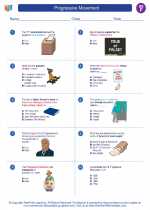Progressive Movement
What is the Progressive Movement? During the Progressive movement, citizens found out how poorly people were being treated and tried to change this. Progressives asked for help from the government and they agreed. Amendments were passed to help citizens. Women’s Suffrage and Prohibition were two of these amendments. Read More...
◂Social Studies Worksheets and Study Guides Sixth Grade. Progressive Movement
Study Guide Progressive Movement
Progressive Movement  Worksheet/Answer key
Worksheet/Answer key Progressive Movement
Progressive Movement  Worksheet/Answer key
Worksheet/Answer key Progressive Movement
Progressive Movement  Worksheet/Answer key
Worksheet/Answer key Progressive Movement
Progressive Movement 

 Worksheet/Answer key
Worksheet/Answer key
 Worksheet/Answer key
Worksheet/Answer key
 Worksheet/Answer key
Worksheet/Answer key

The resources above cover the following skills:
National Standards for Civics and Government (NSCG)
What are the foundations of the American political system? What are the distinctive characteristics of American society?
Diversity in American society. Students should be able to evaluate, take, and defend positions on the value and challenges of diversity in American life. To achieve this standard, students should be able to
Explain why conflicts have arisen from diversity, using historical and contemporary examples, e.g., North/South conflict; conflict about land, suffrage, and other rights of Native Americans; Catholic/Protestant conflicts in the nineteenth century; conflict about civil rights of minorities and women; present day ethnic conflict in urban settings
What are the foundations of the American political system? What is American political culture?
The character of American political conflict. Students should be able to describe the character of American political conflict and explain factors that usually prevent violence or that lower its intensity. To achieve this standard, students should be able to
Describe political conflict in the United States both historically and at present, such as conflict about
Extending the franchise
Engaging in wars
What are the foundations of the American political system? What values and principles are basic to American constitutional democracy?
Fundamental values and principles. Students should be able to explain the meaning and importance of the fundamental values and principles of American constitutional democracy. To achieve this standard, students should be able to
Identify fundamental values and principles as expressed in
Individual and group actions that embody fundamental values and principles, e.g., suffrage and civil rights movements
Disparities between ideals and reality in American political and social life. Students should be able to evaluate, take, and defend positions on issues concerning ways and means to reduce disparities between American ideals and realities. To achieve this standard, students should be able to
Describe historical and contemporary efforts to reduce discrepancies between ideals and the reality of American public life, e.g., abolition, suffrage, civil rights, and environmental protection movements
How does the government established by the constitution embody the purposes, values, and principles of American democracy? How does the American political system provide for choice and opportunities for participation?
Political parties, campaigns, and elections. Students should be able to explain how political parties, campaigns, and elections provide opportunities for citizens to participate in the political process. To achieve this standard, students should be able to
Describe the role of political parties
Associations and groups. Students should be able to explain how interest groups, unions, and professional organizations provide opportunities for citizens to participate in the political process. To achieve this standard, students should be able to
Describe the historical roles of prominent associations and groups in local, state, or national politics, e.g., abolitionists, suffragists, labor unions, agricultural organizations, civil rights groups, religious organizations
What are the roles of the citizen in American democracy? How can citizens take part in civic life?
Forms of political participation. Students should be able to describe the means by which Americans can monitor and influence politics and government. To achieve this standard, students should be able to
Explain how Americans can use the following means to monitor and influence politics and government at local, state, and national levels
Joining political parties, interest groups, and other organizations that attempt to influence public policy and elections
Describe historical and current examples of citizen movements seeking to promote individual rights and the common good, e.g., abolition, suffrage, labor and civil rights movements
Political leadership and public service. Students should be able to explain the importance of political leadership and public service in a constitutional democracy. To achieve this standard, students should be able to
Evaluate the role of ''the loyal opposition'' in a constitutional democracy
National Content Standards in Economics (NCSE)
Institutions
Students will understand that institutions evolve and are created to help individuals and groups accomplish their goals. Banks, labor unions, markets, corporations, legal systems, and not-for-profit organizations are examples of important institutions. A different kind of institution, clearly defined and enforced property rights, is essential to a market economy. Students will be able to use this knowledge to describe the roles of various economic institutions and explain the importance of property rights in a market economy.
At the completion of Grade 8, students will use this knowledge to:
Read about the establishment of a labor union and explain why it emerged, how it influenced the U.S. economy, and what procedures it used to gain benefits for its members and workers in general.
National Center for History in Schools (NCHS)
Historical Thinking Standards
Historical Comprehension
Reconstruct the literal meaning of a historical passage.
United States History Content Standards
Era 4: Expansion and Reform (1801-1861)
The sources and character of cultural, religious, and social reform movements in the antebellum period.
The student understands how Americans strived to reform society and create a distinct culture.
The student understands changing gender roles and the ideas and activities of women reformers.
Era 6: The Development of the Industrial United States (1870-1900)
Massive immigration after 1870 and how new social patterns, conflicts, and ideas of national unity developed amid growing cultural diversity.
The student understands "scientific racism", race relations, and the struggle for equal rights.
The student understands how new cultural movements at different social levels affected American life.
The rise of the American labor movement and how political issues reflected social and economic changes.
The student understands the rise of national labor unions and the role of state and federal governments in labor conflicts.
The student understands how Americans grappled with social, economic, and political issues.
Era 7: The Emergence of Modern America (1890-1930)
How Progressives and others addressed problems of industrial capitalism, urbanization, and political corruption.
The student understands the origin of the Progressives and the coalitions they formed to deal with issues at the local and state levels.
The student understands Progressivism at the national level.
The student understands the limitations of Progressivism and the alternatives offered by various groups.
The changing role of the United States in world affairs through World War I.
The student understands how the American role in the world changed in the early 20th century.
The student understands the causes of World War I and why the United States intervened.
World History Content Standards
Era 7: An Age of Revolutions, 1750-1914
Patterns of nationalism, state-building, and social reform in Europe and the Americas, 1830-1914.
The student understands the political, economic, and social transformations in the Americas in the 19th century.